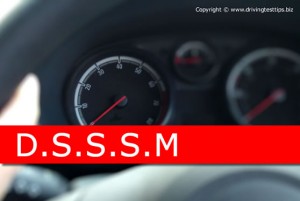As a complete novice learner driver, the first lesson will involve being taught the cockpit drill. The cockpit drill is a process for setting the car up to comfortably and safely drive.
See the full cockpit drill tutorial for further information. To aid learners in remembering the cockpit drill process, the DSSSM routine is used. DSSSM stands for Doors, Seats, Steering, Seat Belt and Mirrors.
Initially, DSSSM takes a while to master and remember, but as driving lessons progress, it eventually takes no more than a minute or so to complete and becomes second nature. This tutorial explains what the DSSSM routine is and how to apply it.
DSSSM driving routine
The DSSSM routine must be done by every learner driver at the start of each driving lesson before driving the car. A full DSSSM or cockpit drill is not often necessary on a driving test when you enter the car with the examiner, unless:
- the car has not been previously set up for you
- the seat, steering or mirrors have been altered

However, before starting the car with the examiner, ensure all doors are shut correctly and seat belts are applied. A brief check of the seating position, steering position and mirrors may benefit you if you feel that an alteration is necessary.
Doors
Legally as the driver of the car, it is your responsibility to make sure all doors (including the boot) are correctly shut. When you have entered your car, ensure your door is shut and your passengers. If your door is not shut correctly, before opening check over your right shoulder in the blind spot to ensure no vehicles or cyclists are approaching.
Seat
The car seat must be positioned so that you can comfortably reach the foot pedals. The correct seating position is judged by placing your left foot onto the clutch pedal and pressing to the floor. Adjust the seat so there is a slight bend in the knee. Once you have found a suitable and comfortable position that the clutch can be operated with, ensure the seat has locked into position. The head restraint may also need adjusting. The centre of the head restraint should line up approximately with your ears. Correct head restraint adjustment can help to minimise whiplash injuries in the event of an accident.
Steering
The back of the seat needs to be lowered or raised so that the steering wheel can be safely and comfortably held. Adjust the seat so that your arms have a slight bend whilst holding the steering wheel at the very top with both hands. The instructor will explain the correct steering technique and how to hold the steering wheel. The steering a car tutorial explains these techniques.
Seat belt
Although a seat belt can legally be removed whilst reversing (including the driving test) it must be worn at all times whilst moving forward. Even moving forward a slight distance during a driving test will result in a failure. Ensure seat belts are secured correctly during a driving test with no twists or turns. As the driver of a vehicle, you are also legally responsible for anyone under the age of 14 to be safely and legally secured in the vehicle.
Mirrors
Now that everything is set up correctly, this leaves the mirrors. If you adjusted the mirrors before the seat, the mirrors would need adjusting again, so it’s important that all is accomplished in this order. Mirrors need to be adjusted so to have the best possible view of behind the car. Try to avoid touching the glass when adjusting as this will blur the image when driving at night. A guide to the correct mirror adjustment can be found in the cockpit drill and mirror adjustment tutorials.
OTHER DRIVING ROUTINES USED FOR LEARNING TO DRIVE
- Driving routines
- POM – Prepare, Observe and Move
- MSM – Mirror Signal Manoeuvre
- SCALP – Safe, Convenient, and Legal Position
- MSPSL – Mirror, Signal, Position, Speed and Look
- LADA – Look, Assess, Decide and Act
